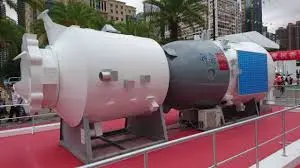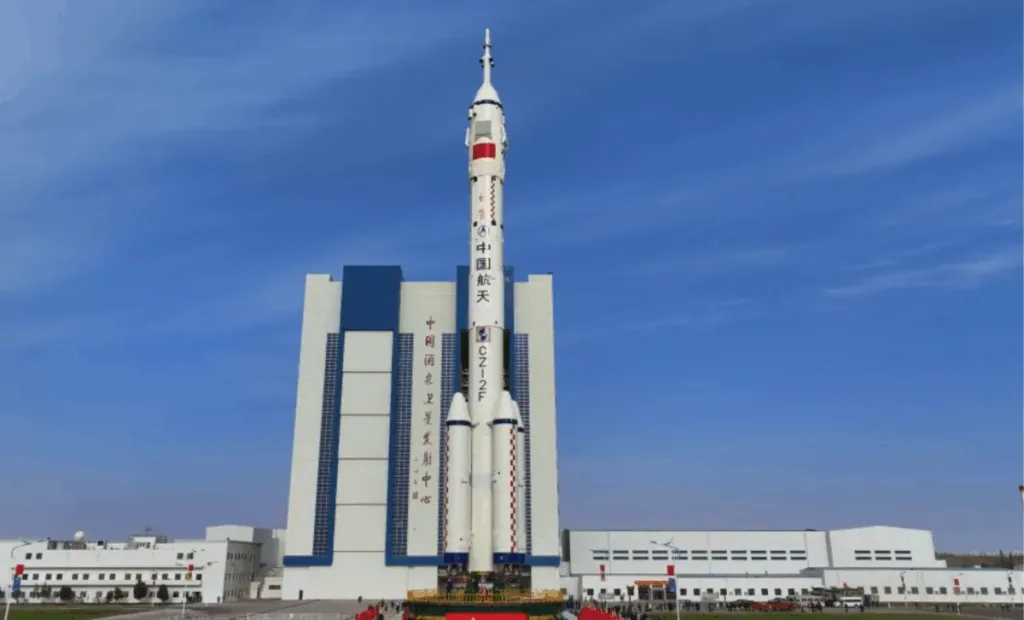BY:SpaceEyeNews.
China’s Tiangong space station has just lived through one of the most dramatic weeks in its short history. A tiny piece of space debris cracked the window of a Shenzhou return capsule, forced mission controllers to improvise a rescue, and left the new crew without a ride home. The result: Shenzhou-21 astronauts stranded in space, safe and working, but dependent on a future “lifeboat” spacecraft to bring them back to Earth.Reuters+1
In this in-depth report, we look at what happened to Shenzhou-20, why the Shenzhou-21 astronauts stranded in space became the focus of global attention, and how the planned Shenzhou-22 mission aims to close a serious gap in human-spaceflight safety.Space+1
From routine crew rotation to emergency rescue
For Tiangong, November 2025 was supposed to be simple. The Shenzhou-20 crew — Wang Jie, Chen Zhongrui and Chen Dong — had spent around six months aboard the station and were scheduled to return to Earth on 5 November in their own Shenzhou-20 spacecraft. A new trio, Zhang Lu, Wu Fei and Zhang Hongzhang, would arrive on Shenzhou-21, overlap for a short handover, and then continue the mission for another six months.Live Science+1
Shenzhou-21 launched on 31 October atop a Long March 2F rocket from the Jiuquan Satellite Launch Center, docking with Tiangong in just three and a half hours — a new Chinese record for a crewed rendezvous. On board were veteran commander Zhang Lu and two first-time astronauts, including 32-year-old Wu Fei, China’s youngest spacefarer so far.Reuters+1 The plan was that the Shenzhou-21 astronauts stranded in space today would simply have been the station’s next routine crew.
That calm picture changed when engineers noticed something disturbing on Shenzhou-20. Inspections revealed tiny cracks in a window of the return capsule’s viewing port, likely caused by a collision with fast-moving orbital debris. China’s human spaceflight agency postponed the return and began tests to understand how serious the damage was.Reuters+1

The decision that left Shenzhou-21 astronauts stranded in space
The Shenzhou-20 crew were not in immediate danger on Tiangong itself. The station remained healthy, and the damaged capsule stayed docked. But no agency wants its astronauts to re-enter Earth’s atmosphere in a vehicle with a cracked window, even if the damage looks minor. Instead of accepting that risk, controllers looked at the newest spacecraft in orbit: Shenzhou-21.Reuters+1
Shenzhou-21 had just arrived with a pristine return module. Mission planners decided that the safest course was to use this fresh vehicle to bring the Shenzhou-20 crew home. In mid-November, Wang Jie, Chen Zhongrui and Chen Dong strapped into the Shenzhou-21 return capsule, undocked from Tiangong and landed safely at the Dongfeng site in Inner Mongolia after 204 days in space — the longest single Chinese spaceflight to date.Reuters+1
From the perspective of those astronauts, the story ended well. From the perspective of station safety, a new problem had just begun. By sending Shenzhou-20’s crew home in the Shenzhou-21 capsule, China effectively removed the only certified escape vehicle for the replacement crew. The Shenzhou-21 astronauts stranded in space still had a functioning space station, but no dedicated spacecraft attached that could carry them back to Earth in an emergency.Live Science+1
China’s space agency has long said it keeps a backup Shenzhou spacecraft and a Long March 2F rocket on standby, ready to launch a lifeboat mission in a little over a week if required.Space+1 However, orbital dynamics do not always cooperate. To rendezvous with Tiangong, a launch must happen when the station passes over the right part of Earth. In this case, that meant waiting close to three weeks between the discovery of the cracks and the planned liftoff of the replacement ship.Space+1
Why experts are uneasy about this “no lifeboat” window

Space agencies accept risk, but they try to reduce single points of failure wherever possible. That is why the Shenzhou-21 astronauts stranded in space have attracted so much attention. For now, if a serious issue forced an immediate evacuation of Tiangong — for example, a major leak or another piece of debris striking a critical module — the crew would not have a fully qualified spacecraft waiting like a lifeboat at the airlock.Live Science+1
Some analysts note that, in a truly extreme emergency, the damaged Shenzhou-20 capsule might still be able to bring the crew home. A Shenzhou vehicle is divided into three parts: an orbital module, a service module and the re-entry module that houses the heat shield and parachutes. If the cracks affect only a non-critical window, engineers could choose to risk a one-time descent.Reuters+1 That option, however, falls far short of the redundancy standards normally expected in modern human spaceflight.
Outside experts have described the situation as “disconcerting” because, unlike similar episodes on the International Space Station, there is currently no alternative capsule already docked that can definitely bring the Shenzhou-21 astronauts stranded in space back to Earth. On the ISS, when spacecraft trouble prolonged crews’ missions, other return vehicles — Soyuz or SpaceX Crew Dragon — remained ready as backup options. At Tiangong, redundancy exists only on paper until Shenzhou-22 arrives and successfully docks.Live Science+1
The episode also raises questions about station capacity. Tiangong is roughly one-fifth the size of the ISS, yet it has demonstrated it can support six astronauts for a short overlap.Live Science+1 Some observers wonder whether China chose to prioritise returning the older crew quickly over waiting until a new lifeboat was in place, even if that choice temporarily compromised evacuation options for the new team.
Shenzhou-22: the lifeboat for Shenzhou-21 astronauts stranded in space
China’s answer to this gap is Shenzhou-22. According to SpaceNews and related reports, the China Manned Space Agency plans to launch an uncrewed Shenzhou-22 spacecraft on 25 November. Its primary job is clear: provide a safe ride home for the Shenzhou-21 astronauts stranded in space and restore Tiangong’s escape capability.Space+1
The mission profile is straightforward but crucial. A Long March 2F rocket will lift Shenzhou-22 from Jiuquan into low Earth orbit. After a series of orbit-raising burns and alignment manoeuvres, the spacecraft will rendezvous and dock with Tiangong. Once attached, it becomes both a lifeboat and a resupply ship, carrying fresh food, scientific equipment and possibly spare parts to offset the busy weeks the station has just endured.Space+1
Only after Shenzhou-22 is securely docked can mission controllers safely dispose of the damaged Shenzhou-20 capsule. Current plans, based on expert commentary, suggest they will undock the vessel and command a controlled re-entry over the South Pacific, where any surviving fragments will fall far from populated areas.Reuters+1 That step removes a compromised spacecraft from the station’s “parking lot” and simplifies operations for future missions.
For Zhang Lu, Wu Fei and Zhang Hongzhang, the arrival of Shenzhou-22 should turn their story from “Shenzhou-21 astronauts stranded in space” back into what it was always meant to be: a six-month expedition packed with experiments. Their mission list includes work in biotechnology, space medicine and materials science, as well as monitoring how the station’s systems age under continuous use.AP News+1
Debris, redundancy and the new reality of human spaceflight
The Shenzhou-21 episode underlines a broader truth: low Earth orbit is no longer an empty ocean. The space around Earth is crowded with satellites, rocket stages and tiny fragments left over from past missions and anti-satellite tests. Even a millimetre-sized piece of metal can hit at several kilometres per second and gouge a spacecraft window, as Shenzhou-20’s crew discovered.Reuters+1
Engineers have built shielding and avoidance systems for decades, but debris problems are getting harder, not easier. Each new collision has the potential to create more fragments, which then spread into other orbits and increase the risk for everyone. Shenzhou-20 is not the first human-rated spacecraft to deal with unexpected damage, and it will not be the last.
This is why redundancy matters. A modern space station is more than a laboratory; it is a small, isolated habitat where the crew cannot simply walk outside if something goes wrong. On the ISS, partner agencies agreed early on that at least one safe return vehicle must always be docked for each set of seats in orbit. Commercial crew vehicles now add extra flexibility. The story of the Shenzhou-21 astronauts stranded in space shows that Tiangong is still refining its own version of these safety norms.
China has already made clear that it can keep a standby rocket and Shenzhou spacecraft ready on Earth.Space+1 The next step may be baking more explicit “no-lifeboat windows” into mission planning. For example, future rotations could wait to swap crews until a fresh return capsule is already in place, or they could keep two spacecraft docked whenever six astronauts share the station.
What this means for China’s space ambitions
Despite the current concern, Tiangong remains a major achievement. Since 2021, China has built, assembled and continuously occupied its own modular station, hosted multiple long-duration crews and carried out hundreds of experiments. The Shenzhou-21 mission also represents a generational shift, with younger astronauts like Wu Fei flying alongside veterans, and even mice joining the crew to test how mammals adapt to life in orbit.Reuters+1
The way China handles the Shenzhou-21 astronauts stranded in space will send a signal far beyond one mission. The country aims to land astronauts on the Moon by around 2030 and plans to invite international partners, including Pakistan, to fly on Tiangong.Reuters+1 Those goals require not only powerful rockets and advanced spacecraft, but also transparent, robust procedures for handling unexpected problems.
In that sense, the debris strike and the rushed use of Shenzhou-21 as a rescue capsule can act as a wake-up call. It highlights the importance of open communication about risks and contingency plans, especially when crews from other nations may soon share the same station. Clear lifeboat strategies will become even more critical if China builds larger stations or participates in deep-space habitats where launch-on-demand rescue is impossible.
Lessons from Shenzhou-21 astronauts stranded in space
For the Shenzhou-21 astronauts stranded in space, daily life on Tiangong likely feels quite normal. They run experiments, maintain the station and talk with their families back on Earth. Yet the story unfolding around them is anything but routine. A tiny piece of debris forced a chain of decisions that saved one crew but temporarily removed the escape path for another.Live Science+1
When Shenzhou-22 finally docks and restores a clear way home, this episode will probably be remembered as a successful test under pressure. China protected the Shenzhou-20 crew, reacted quickly to a real debris strike and moved to give the Shenzhou-21 team a new lifeboat. At the same time, it exposed how narrow the margins can be when a space station relies on a single return spacecraft.Reuters+1
For the global space community, the key lesson is simple. As more nations and companies send people into orbit, missions must assume that debris strikes and other surprises will occur. Redundant vehicles, clear lifeboat rules and honest reporting will decide whether “stranded” stories become rare footnotes or regular headlines.
The phrase “Shenzhou-21 astronauts stranded in space” may sound dramatic, but it captures a real, if temporary, vulnerability. How China responds now will shape not only the safety culture of Tiangong, but also the confidence of future partners and the design of the next generation of space stations and lunar bases.
References:
https://www.livescience.com/space/space-exploration/three-more-chinese-astronauts-are-now-stranded-in-space-following-successful-rescue-of-their-colleagues
https://spacenews.com/china-to-launch-shenzhou-22-spacecraft-nov-25-to-provide-lifeboat-for-astronauts/